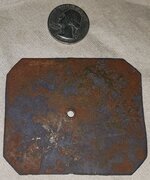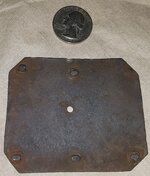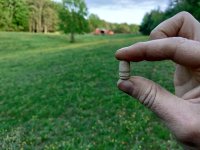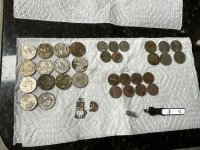fieldslayer
Jr. Member
Trunk plates ......time to re-examine
......time to re-examine
Fellow RW Enthusiacs - If I may, I would like to resolve a long time "pet peave" of mine I have been bothered by for some time , and would welcome any discussion, proof on this topic to settle it once and for all. I have been successfully hunting and researching rev war artifacts + attending relic shows since the late 1970's. I don't know how this assumtion arose, but so many classic looking plates such as shown in the previous post (correct size, clipped corners, etc.) have always been dismissed as "trunk plates" due to the presence of the studs on the back, even by some of the biggest authorities in the field. Aside from being an avid relic hunter, I have been in the antique business even longer. I have made it a sort of mission to find the evidence of this. To date, after seeing hundreds of examples of period trunks of all types, + consulting trunk experts and museums, I have yet to see one even similar example of such a brass attachment anywhere in my research. Also, is the GR example with studs in the Neumann and Kravic Encyclopedia book labled a cartridge box plate a mistake? By the numbers of these plates uncovered, it would be assumed that these were quite common on trunks. Where is the surviving trunk evidence This belief has been cliche for so many decades , that it apparently has never been questioned. I would welcome any commentary or proof otherwise, before anymore possible valid plates are dismissed.
This belief has been cliche for so many decades , that it apparently has never been questioned. I would welcome any commentary or proof otherwise, before anymore possible valid plates are dismissed.
 ......time to re-examine
......time to re-examineFellow RW Enthusiacs - If I may, I would like to resolve a long time "pet peave" of mine I have been bothered by for some time , and would welcome any discussion, proof on this topic to settle it once and for all. I have been successfully hunting and researching rev war artifacts + attending relic shows since the late 1970's. I don't know how this assumtion arose, but so many classic looking plates such as shown in the previous post (correct size, clipped corners, etc.) have always been dismissed as "trunk plates" due to the presence of the studs on the back, even by some of the biggest authorities in the field. Aside from being an avid relic hunter, I have been in the antique business even longer. I have made it a sort of mission to find the evidence of this. To date, after seeing hundreds of examples of period trunks of all types, + consulting trunk experts and museums, I have yet to see one even similar example of such a brass attachment anywhere in my research. Also, is the GR example with studs in the Neumann and Kravic Encyclopedia book labled a cartridge box plate a mistake? By the numbers of these plates uncovered, it would be assumed that these were quite common on trunks. Where is the surviving trunk evidence
 This belief has been cliche for so many decades , that it apparently has never been questioned. I would welcome any commentary or proof otherwise, before anymore possible valid plates are dismissed.
This belief has been cliche for so many decades , that it apparently has never been questioned. I would welcome any commentary or proof otherwise, before anymore possible valid plates are dismissed.
Upvote
1







